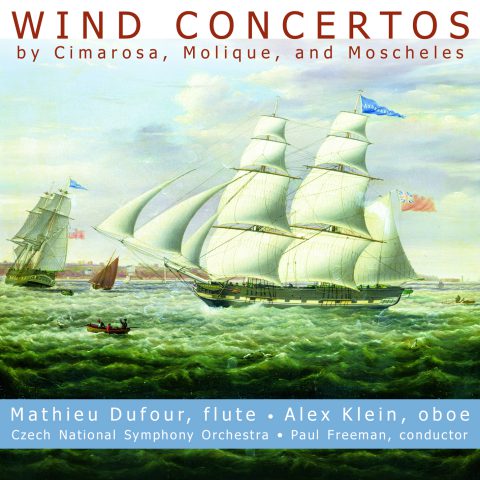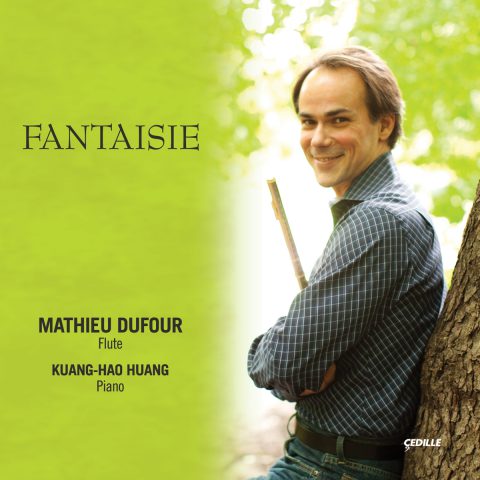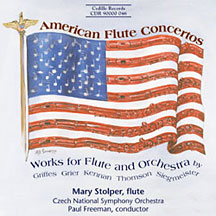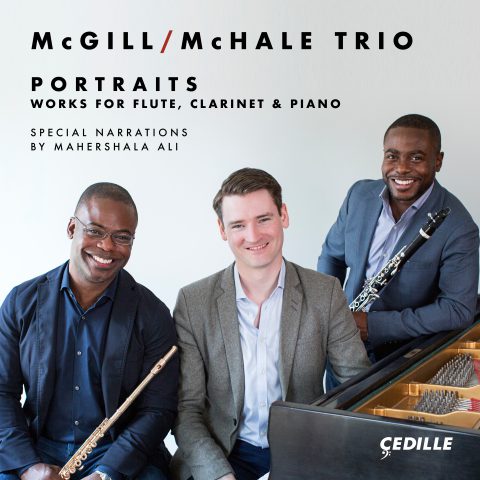Store
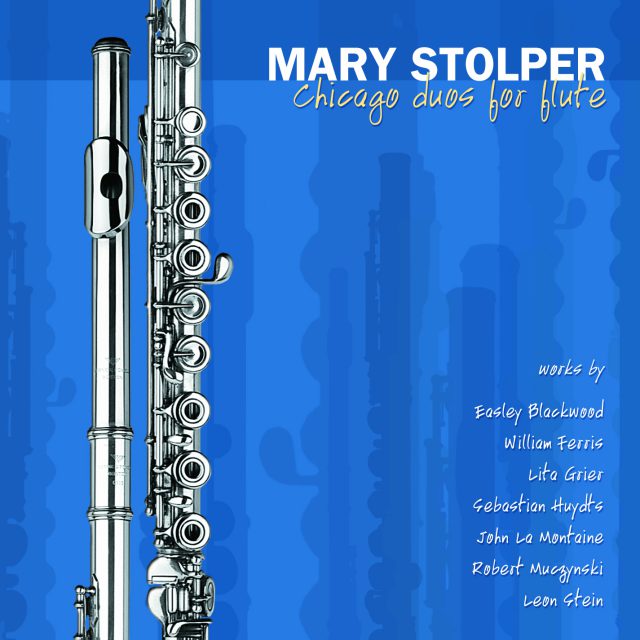
Store
Chicago Duos for Flute
Eric Mandat, Denis Azabagić, Sebastian Huydts, Easley Blackwood, William Ferris, Lita Grier, John La Montaine, Robert Muczynski, Leon Stein, Keith Conant
Each of the composers represented on this recording is a Chicago composer, but you won’t find a “Chicago School” here. These are seven unique individuals whose lives have been touched in different ways by this heartland center. Some were born and educated here, then moved away; others came from abroad and adopted Chicago as their home; still others spent virtually their entire productive lives in this city. All write music that is imaginative and earnest. Their subject in these works is the flute paired with another instrument. Throughout the recording, the flute (or piccolo), like a gracious hostess at a party, moves with suppleness between its musical guests, entering into dialogues on widely disparate topics. The result is a delightful assortment of Real Music.
Preview Excerpts
LITA GRIER (b. 1937)
3x2 for Flute and Clarinet
EASLEY BLACKWOOD (b. 1933)
LEON STEIN (1910-2002)
JOHN LA MONTAINE (b. 1920)
Sonata for Piccolo and Piano Op. 61
WILLIAM FERRIS (1937-2000)
Duos for Flute and Clarinet Op. 34 (1984) (selection)
SEBASTIAN HUYDTS (b. 1966)
Music for Flute and Piano Op. 22c
Artists
1: with Eric Mandat, clarinet
4: with Denis Azabagic, guitar
5: with Jim Ross, percussion
6: with Melody Lord, piano
10: with Keith Conant, viola
11: with Eric Mandat, clarinet
14: with Sebastian Huydts, piano
Program Notes
Download Album BookletChicago Duos for Flute
Notes by Ted Hatmaker
Mention the city of Chicago to most people and it’s a good bet their first response won’t be “art music.” Despite its world-class orchestra, opera house, music schools, libraries, and abundant musical institutions, Chicago’s reputation is shaped mostly by other aspects of its rich history and colorful character. Simply put, art music in Chicago is overshadowed by the sensational, the high profile, the popular, and the macabre. Tall buildings, gangsters, and slaughtered hogs carve a more vivid image in our collective mind. Yet somewhere amidst Sandburg’s “Big Shoulders” and Algren’s hustlers lives a muse who guides its musical travelers in an extraordinary way. The world should know that this city’s music bursts forth with an immediacy and heartiness that is as alive as Chicago itself. Author Scott Turow dubbed Chicago “The Capital of Real Life,” by virtue of its substance and character. I think the city could just as aptly be called The Capital of Real Music: sincere music that is brilliantly constructed, music without pretense.
Each of the composers represented on this recording is a Chicago composer, but you won’t find a “Chicago School” here. These are eight unique individuals whose lives have been touched in different ways by this heartland center. Some were born and educated here, then moved away; others came from abroad and adopted Chicago as their home; still others spent virtually their entire productive lives in this city. All write music that is imaginative and earnest. Their subject in these works is the flute paired with another instrument. Throughout the recording, the flute (or alto flute or piccolo), like a gracious hostess at a party, moves with suppleness between its musical guests, entering into dialogues on widely disparate topics. The result is a delightful assortment of Real Music.
William Ferris (1937–2000)
William Ferris spent most of his life in Chicago. An accomplished organist and choirmaster, Ferris directed most of his musical activities toward the Roman Catholic Church and the internationally acclaimed William Ferris Chorale, an ensemble specializing in twentieth-century works. Educated entirely in Chicago, he served as organist for Chicago’s Holy Name Cathedral and later as Music Director and Composer-in-Residence at Our Lady of Mount Carmel Church. He was the first American composer to teach in the Vatican. In 1989, Pope John Paul II conferred upon him a Papal knighthood. Ferris’s compositional distinctions include performances by the Chicago Symphony Orchestra, a premiere at the 1986 Aldeburgh Festival, and a Pulitzer Prize nomination in 1980. His death in 2000, during a rehearsal of Verdi’s Requiem, sent a shock through the entire musical community.
Ferris’s poignantly expressive Lux Aeterna (1997) for flute and viola shows a reflective side of his spirituality. Its contrapuntal web avoids tonal centers and functional harmony, yet yields a nostalgic sweetness, derived largely from its motivic use of the interval of a sixth and the absence of harsh dissonances. The flute and viola act as equal partners over a continuum of delicate moods and soft colors. The dialogue is broken by a short, urgent viola cadenza and a more extended and relaxed flute cadenza, after which the interchange concludes with a quiet lullaby and a final, summarizing duet.
Leon Stein (1910-2002)
Leon Stein was a central figure for music composition in Chicago over most of the twentieth century. Born and raised on Chicago’s West Side, Stein learned violin as a youth at the American Conservatory of Music. His academic center, however, was DePaul University, where he earned masters and doctorate degrees and taught from 1931 until his retirement in 1978, serving (among many functions) as Dean of the School of Music from 1966. Stein’s diverse interests, including conducting local orchestras and writing on music theory and Jewish music, were balanced by a strong sense of family.
A prolific composer, Stein wrote for a wide variety of instrumental combinations. He completed his Introduction and Rondo for flute and percussion in 1960. The piece places the melodious flute against a percussion battery that incorporates various sizes of drums and cymbals. A free-form introduction creates an exotic mood through sporadic percussion attacks and modal scalar flute patterns. Its tentative nature is replaced by a jaunty rondo statement — a polytonal flute theme played over a lumbering drum ostinato. The ostinato becomes more animated and the flute more chromatic in contrasting sections. Grand ascending gestures in the flute summon the work’s conclusion.
Easley Blackwood (b. 1933)
Easley Blackwood is one of the mainstays of the Chicago music scene. A productive member of the University of Chicago’s Composition Department for over forty years (now Professor Emeritus), the Indianapolis-born Blackwood has been heralded both for his performances as a pianist, including as part of the ensemble Chicago Pro Musica, and for his highly respected compositions. A student of Messiaen, Hindemith, and Boulanger, Blackwood followed a mostly atonal polyrhythmic compositional path from the 1950s through the 1970s. In the late ’70s, he discovered anew the relations inherent in diatonicism and has focused on tonal composition ever since.
The combination of flute and guitar in Blackwood’s Rondo Caprice (1993) looks back to its usage in the eighteenth and early nineteenth centuries — a focus reflected both in harmonic language and formal content. The smooth, idiomatic flow of the two instruments’ lines imbues the piece with a sense of propriety. The rondo title stems from the varied reprise of its opening minor-key statement, but this is really a hybrid form, with contrasting sections that are discrete classical models: a minuet, a sonatina, and two dances typical of a baroque suite (gavotte and gigue). The astute listener will enjoy the game of keys Blackwood offers: During the course of this classical-sounding work, every key of the chromatic scale is embraced at least once.
Robert Muczynski (b. 1929)
Born in Chicago in 1929, Robert Muczynski received his advanced musical education (BM 1950, MM 1952) at DePaul University. He excelled in both composition and piano performance (he played his own Divertimento for Piano and Orchestra with the DePaul University Symphony Orchestra at his graduation). Numerous fellowships, awards, and commissions followed, including those from the Fromm Foundation, the Louisville Symphony, the Grant Park Orchestra, and the Ford Foundation. His Concerto for Alto Saxophone and Orchestra was nominated for a Pulitzer Prize in 1982. Muczynski has taught at DePaul; Loras College in Dubuque, Iowa; and, from 1965, at the University of Arizona.
Muczynski originally wrote his Duos op. 34 for two flutes in 1973. Years later, he revised the piece for the combination of flute and clarinet. Despite their brevity, each of these six miniatures is satisfyingly complete in itself. Alternating slow, reflective movements with spirited allegros, the flute and clarinet create a compelling interplay of chromatic filigree.
John La Montaine (b. 1920)
John La Montaine was born in Chicago in 1920 and began his formal musical studies at the American Conservatory of Music there. La Montaine went on to study at Eastman, Juilliard, and with Nadia Boulanger at the American Conservatory in Fontainebleau. La Montaine’s keyboard skills gained him the position of pianist and celesta player in Toscanini’s NBC Orchestra from 1950–54. Because composition seemed too uncertain as a career, he also studied to become a stockbroker. In 1959, however, his Piano Concerto (commissioned by the Ford Foundation) won the Pulitzer Prize. Two Guggenheim Fellowships and an award from the Academy of Arts and Letters soon followed, so La Montaine returned to composition permanently. Much of his life since then has been based in Hollywood, California. His particular musical interests include sounds of nature, especially those of birds, which he has incorporated into his music in works such as Mass of Nature for narrator, chorus, and orchestra, and Birds of Paradise for piano and orchestra.
La Montaine’s Sonata for Piccolo and Piano, published in 1993, comprises the traditional four-movement format. The opening movement is sonata in form, with an ebullient first theme in changing meter and a gentle, almost hypnotic second theme. The second movement, marked “Sorrowing,” is a tender and mournful piccolo melody anchored by parallel piano triads. A most intimate reflection, it casts the piccolo in a lyrical role with which it is too seldom associated. The brief, groping third movement, for piccolo alone, seems to be searching for the right motive with which to continue. It settles on the ascending sixth, from which a theme is forged to start the finale. The finale plows playfully through all twelve chromatic keys — subtracting a flat or adding a sharp — until we return enharmonically to the opening key of E-flat.
Sebastian Huydts (b. 1966)
Sebastian Huydts was already a rising star in the musical world when he came from his native Amsterdam to attend the University of Chicago in the early’90 s. His piano studies with Edith Grosz and Rian de Waal at the Sweelinck Conservatory brought him performances throughout Northern Europe as a recitalist, soloist, and chamber player. Since arriving at Chicago, his focus has been largely toward composition, for which he has been in increasing demand. His mentors have included John Eaton, Andrew Imbrie, Shulamit Ran, and Jay Alan Yim. Huydts has received commissions from the DuPage Symphony Orchestra, the Rembrandt Chamber Players, and the Rhijnauwen Chamber Music Festival, and premieres by the University of Chicago Symphony Orchestra and Contemporary Chamber Players. In 1995, his Concerto for Piano and Double String Orchestra was awarded the Paul and Olga Menn prize for original compositions. Since completing his formal education, Sebastian Huydts has worked throughout the city including teaching positions at Lake Forest College, Northwestern University, and the Merit Music Program. He has been Artist-in-Residence at Chicago’s Columbia College since 1998 and currently serves as Composer-in-Residence for the Music in the Loft concert series and the new music ensemble CUBE.
Written in 1997 at the request of flutist Elizabeth Ko, Music for Flute and Piano requires virtuoso skills from both instrumentalists. The first of its four movements, described as a slow fantasia, contains inquiring figures that grow from a haunting rearticulation motive into improvisatory outbursts and crystalline bell harmonies. The resulting evanescence continues at the start of the succeeding Allegro ben ritmico, but abruptly yields to a brilliant marchlike duel with a polytonal flavor. An intermezzo effects a calming conciliation between the two parties before the march begins anew. The third movement, Winterhaze, paints a dreary musical landscape in shades of gray. Slow, colorless harmonies line vague, arch-like flute phrases that become animated at its climax, only to drop back into its frosty gloom. In the finale, Principio di Virtu, Huydts invokes the spirit of a medieval dance. The upper registers of the flute depict a fife in a lively and incessant modal tune, while the piano provides percussive accompaniment. Occasional open fifths suggest a fiddle harmony. An acrobatic piano interlude casts us momentarily back to modern times, but the dance returns and builds to a rousing conclusion.
Lita Grier
Born in New York City, Lita Grier also lived in Boston and Los Angeles before settling in Chicago in the early 1970s. She has enjoyed much success as President of InterContinental Media, which produced (among others) the acclaimed Salzburg Music Festival broadcasts for American radio. Recently she has focused her writing toward musical theater, and several of her musicals have been produced locally.
3×2 is an exquisite work whose title ostensibly refers to three movements for two instruments, though there are numerous other references to three and two throughout. It is an early composition, written when Grier was a student at Juilliard. It is presented here in its original incarnation for flute and clarinet. Grier later arranged the piece for solo piano, in which form it won the New York Philharmonic Young Composers Prize and was published by Carl Fischer. With a vibrant syncopation and angular lines, the opening presto tiptoes delicately between tertian and quartal tonalities. Both its bustling opening theme and a more bridled contrasting theme allow the flute to set the course, leaving the clarinet to outline harmonies and periodically comment on or join with the flute. The incipient imitation of the wistful second movement weaves an expressive counterpoint. Economical in construction and tightly molded around symmetrical motives, the brief third movement supplies a punctuation mark to the set.
Ted Hatmaker is a music theorist and composer on the faculties of Northern Illinois University and DePaul University.
Album Details
Total Time: 78:54
Recorded: February 26-28, March 29-30, and April 16, 2002 at WFMT Chicago
Producer: Judith Sherman
Engineer: Bill Maylone
Graphic Design: Melanie Germond & Pete Goldlust
Front Cover Photo: Tom Van Eynde
Notes: Ted Hatmaker
PUBLISHERS: Grier © 1953 Lita Grier. Blackwood © 1992 Blackwood Enterprises. Stein © 1977 Southern Music Company. La Montaine © 1993 Freedonia Press. Ferris © 1997 William Ferris. Muczynski © 1984 G. Schirmer. Huydts © SBH1997.
© 2003 Cedille Records/Cedille Chicago
CDR 90000 071
